Kraków 2007-02-07
085b Section 1950-08-20
OKB Jakowlew Jak-17 / W „Agata”
Poland
The first Polish turbojet fighter aircraft.
History
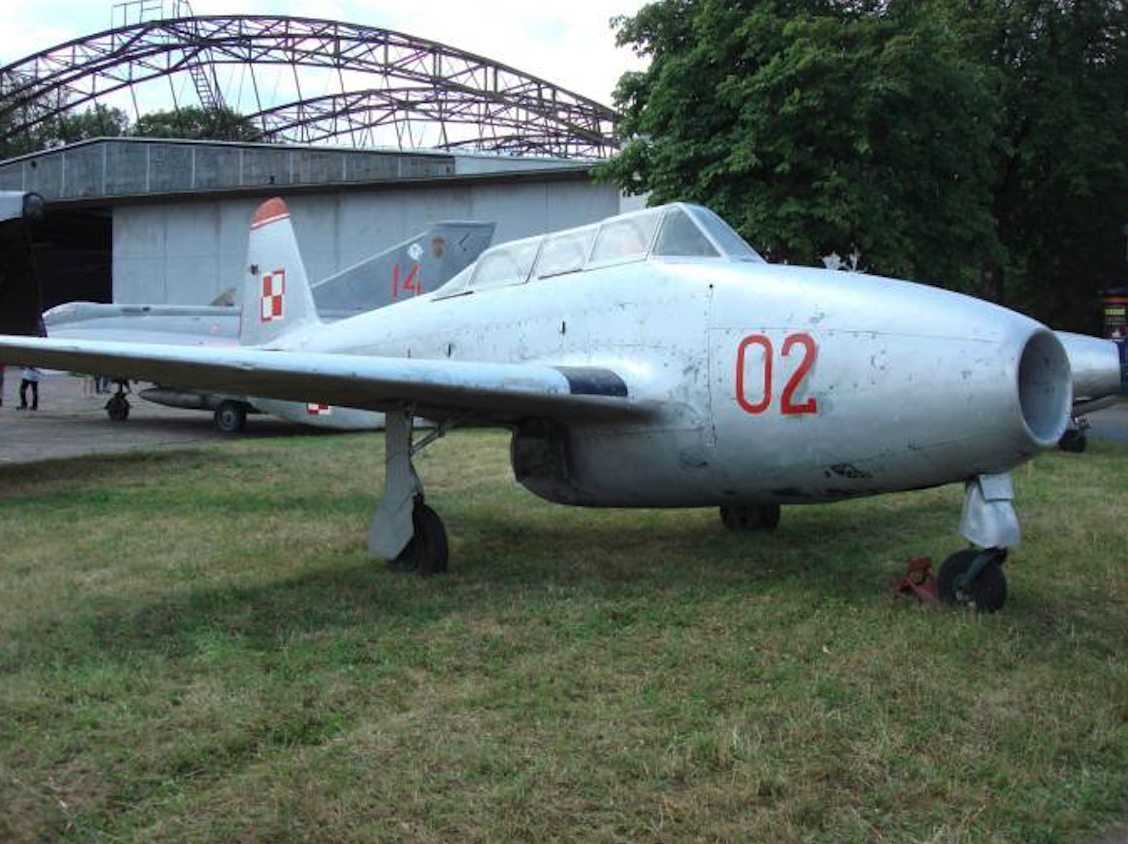
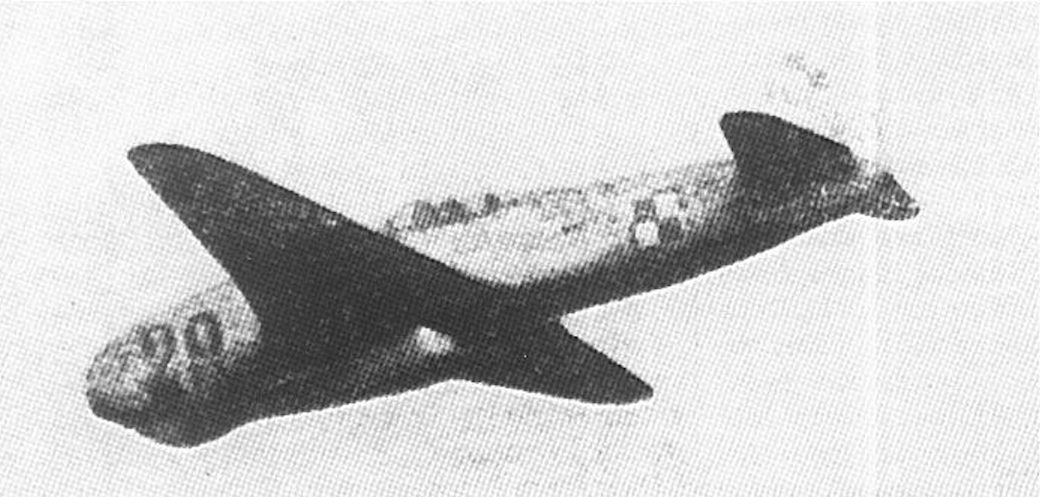


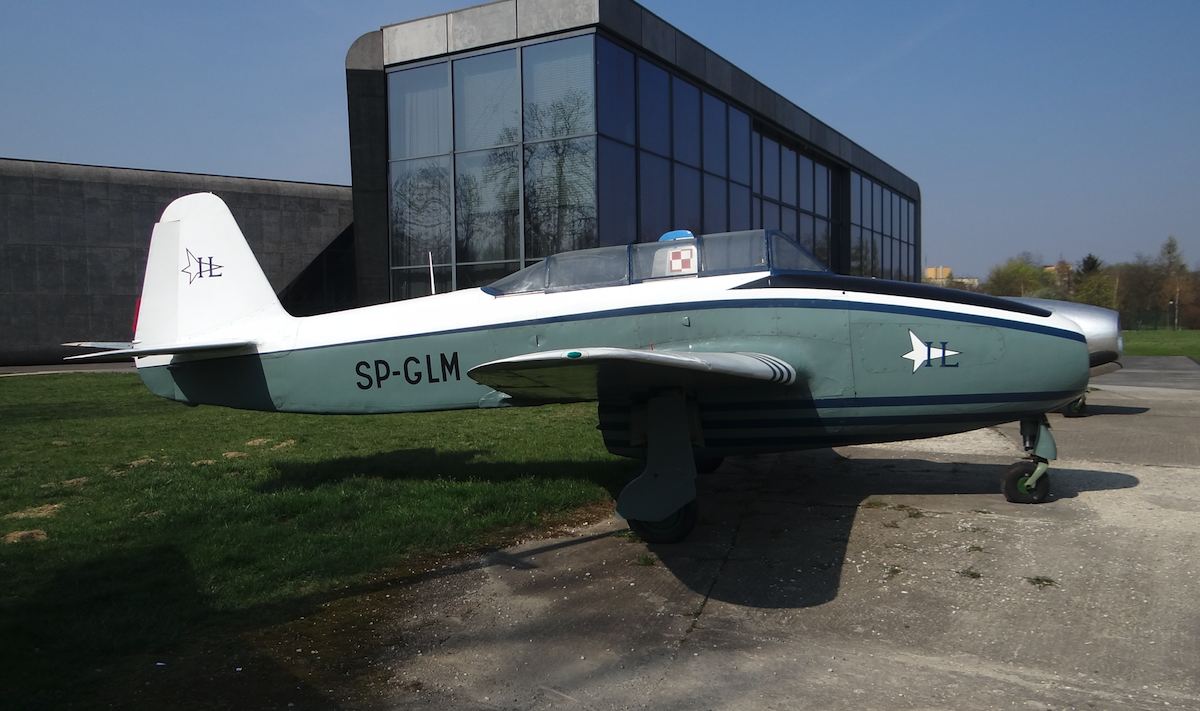
History
Assumptions of the Jak-15 construction.
The Jak-15 aircraft became the first turbojet of the OKB Yakovlev office. The basis was a Jak-3 piston-powered fighter plane, which was decided to be equipped with an RD-10 turbine engine, which is a copy of the Jumo 004 engine. In order not to bring about revolutionary changes, the cabin was arranged identically as in a piston-powered fighter plane. Even the throttle lever remained in the same place. Thanks to this, pilots easily learned the piloting of the aircraft with a new drive.
Serial production of Jak-15 aircraft was launched and about 250 were built. The aircraft was not exported. Its maximum speed was only 786 km / h. British constructions were faster.
Jak-17. 1947 year.
The Jak-17 was a direct development of the Jak-15 front fighter. Initially, this new aircraft was marked with Jak-15 U (service-fitted), but the changes were relatively large, which forced the branding of the new Jak-17.
As a result of the operation of the Jak-15 aircraft, it turned out that the mixed (wood-metal) construction of the machine requires serious strengthening. Elements made of metal, much stronger, began to displace wood, so the structure of the aircraft is almost completely metal.
The tail has changed a lot. The one developed for the Jak-3 on a turbojet turned out to be not very correct. The fixation was redesigned, giving it a larger surface and larger bevels.
Changing the chassis layout was a very good progress. The aircraft received a chassis with a front wheel. Thanks to this, the visibility from the cabin during the machine's movement on the ground has improved significantly. Because there was no room for the front shin in the hull, it was placed outside, and after folding it was covered by a special fairing. The main chassis also had to be redesigned and moved backwards behind the center of gravity. This change resulted in the removal of wing fuel tanks. At the same time, additional droplet shaped fuel tanks were hung at the wing ends.
The changes caused an increase in the take-off mass of the aircraft compared to the Jak-15, by about 400 kg and a decrease in performance, despite the use of a slightly higher thrust engine. Still, the aircraft was a more mature construction. The plane made its first flight on 5 January 1947 (?).
The turbojet engine underwent modernization in the steering unit by engineer J. Kolesnikov and received the designation RD-10 A with 1 x 9.8 kN (1 x 1000 kG). The engine started using a small piston engine, but more on this below. The problem associated with the first turbojet engines was their small resurs. It was only 25 hours of work. The Jak-17 aircraft has a small fuel supply, sufficient for just 20-28 minutes of quiet flight.
Jak-17 W (UTI).
At the turn of 1947 - 1948, a two-seater school-training version was created, marked as Jak-17 W or Jak-17 UTI (training for fighter). It differs from the combat variant with the RSI-6 communication radio used, the lack of weapons and of course a two-seater cabin.
Aircraft production Jak-17, Jak-17 UTI.
The production of Jak-17 aircraft began at the beginning of 1948, lasted until the end of 1949, and closed with the number of approximately 430 machines produced, both one- and two-seater. For the first time, Jak-17 aircraft were presented to the public at the parade in Tuszyno in 1949. The aircraft were introduced to the armament of CCCP aviation.
The planes were also used in other countries, they were basically training and training planes in a very small number. e.g. .; Czechoslovakia - 1 Jak-17 aircraft designated S-100, from 1950. Other countries: Bulgaria, Romania, China also only had a few pieces of these aircraft in the Jak-17 UTI version. Chinese aircraft also served to train North Korean pilots during the Korean War. Yak-17s were not used in combat. The last Jak-17 UTIs were decommissioned in the early 1960s.
Plan of Polish Military Aviation.
In 1948, a seven-year military aviation development plan for 1949-1955 was developed in Poland. These plans referred to the acquisition of new fighter aircraft powered by future propulsion in the form of turbojet engines. The main pros of this type of drive at that time were; much higher top speed, excellent climb speed and simpler design.
Because Poland got into the zone of Soviet (communist) influence, only CCCP could be the only supplier of new equipment. The purchase of Jak-15 aircraft was considered, but CCCP did not dare to sell these machines even to dependent countries. The purchase of Jak-17 and Jak-17 W aircraft, which is a training and training version, turned out to be real.
Jak-17 for Poland. 1950 year.
At the beginning of 1950, Poland bought the first batch of Jak-17 fighters, which consisted of three machines. The planes were brand new. These machines were delivered by one rail transport to Radom and placed in one of the heavily guarded hangars. Each of the aircraft was partially dismantled and placed in crates. Their assembly and handover flights were carried out by Soviet technicians and pilots.
The first Polish Jak-17 aircraft was assembled in July 1950.
Lieutenant Colonel Wasyl Gaszyn, a CCCP citizen serving in the Polish People's Army, was preparing for training flights. He was the first to demonstrate this unique aircraft at the time to selected representatives of the army and civil aviation. Subsequently, it was planned to present the plane to the public at the Aviation Day celebrations.
In the first decade of August 1950, Lt. Col. (Capt.) W. Gaszyn began intensive training flights preparing for the shows. A tire was damaged during one such flight. This meant the end of training flights. At that time, the decision was made to replace the entire wheel with one of the unassembled aircraft stored in Radom. For this purpose, Lt. Col. W. Gaszyn together with Ensign Z. Pietrucha by plane Po-2 flew to Radom. There, with the help of an organized team of technicians and cadets, they pulled one chest out of the hangar and dismantled the wheel from the right panel. They took them to the Po-2 plane and flew back to Warsaw. The wheel was mounted in Jak-17 and training flights were resumed. This method of repair by technical cannibalism is not uncommon in aviation.
First pilots of Polish aircraft Jak-17.
In July 1950, the Air Force Command sent a group of 4 pilots to train on a new type of aircraft; Lieutenant Colonel (Capt.) Wasyl Gaszyn (then a Soviet adviser from the Air Force Command), Lieutenant Colonel Aleksander Markow (Soviet adviser from the Officers' Aviation School in Dęblin), Capt. Andrzej Rybacki from the 1st PLM (fighter regiment), see Kazimierz Tanana from 2nd. PLM.
The training was fast. Capt. Pilot Andrzej Rybacki and lieutenant Kazimierz Tanana made their first independent flights in the first days of August 1950, and by the end of the course, each of them made flights in 6 hours.
In 1951, pilots from the 1st PLM were trained on jet planes; Capt. Więk, Capt. Bajczykow, Capt. Krepski, Capt. Paniewski, second lieutenant Iwoń and lieutenant Smolnik. The next ones were: Dobrzeniecki, second lieutenant Płoszański, second lieutenant Władysław Hermaszewski and others.
All pilots first underwent theoretical and practical training in CCCP on Jak-17 W (Jak-17 UTI) aircraft. Some training also took place in Soviet bases in Poland, for example in the Soviet 159 regiment in Brzeg Opolski.
Beginning of service of the Jak-17 UTI in Poland.
A completely new division was planned for the new type of aircraft, namely the 5th Fighter Aviation Division (DLM). The formation of the tactical union began on April 28, 1950. The 5 DLMs were subordinated initially; 1. Fighter Air Regiment from Modlin, 2. Fighter Air Regiment from Krakow and 3. Fighter Air Regiment from Babich Dół.
On August 20, 1950, demonstrations took place at the Okęcie Airport in Warsaw. As the fourth point on the program, a gray-green fast jet plane appeared around 15:00 above the airport. He flew over the grandstand relatively low and fast, which made a great impression on the viewers. After a short while, the plane returned to the airport and within a few minutes demonstrated to the audience a display of figures of higher potash. It was possible to view the plane reasonably closely. The chessboards and board number 29 were visible. This show made a huge impression and found a place in domestic and foreign press.
The board number 29 on the Polish Yak-17 aircraft is a certain mystery. During the first show, on August 20, 1950, the aircraft had this number in black or dark blue. On subsequent shows nb 29 is yellow. On this basis, it can be concluded that they were two different aircraft. Following this lead, we can assume that one of these aircraft was borrowed from a Soviet unit stationed in Poland.
Airplanes Jak-17 / W (UTI) in Poland by pilots were very nicely named "Agata".
The specificity of the operation of Jak-17 aircraft.
The introduction of a new technique in the form of a turbojet propulsion required mastering new technical and operational processes. Starting the RD-10 engine is complicated and includes several points that pilots and technicians had to master perfectly.
Starting the RD-10 engine: Remove the right and left spark plugs, clean and reinstall. Pour kerosene from the combustion chambers and the exhaust nozzle. Wipe the exhaust nozzle dry. Connect the battery and heat the candle until it reaches 220 degrees C (within 10 minutes). Heat the lamps at an air temperature of –5 degrees C until the thermocouples indicate a temperature of +150 degrees C. Then give the command: "Remove the headrests and wipe the nozzle". Enter the command: "From the nozzle" and move the battery switch down. Turn the engine switch down. Enter the command "Flooding" and press the "Flooding" button for 3-4 seconds. Enter the command: "From nozzle" and press the starter of the combustion engine, simultaneously push the ignition switch to the front position. If the turbine speed increases to 600-800 rpm, switch on the ignition. If the RPM rises to 1,800 - 2,000 RPM, move the fire stopcock and gas throttle forward and watch the temperature of the outgoing gases carefully. It should not be greater than 680 degrees C. Turn off the combustion engine. If the gas temperature is higher than 680 degrees C, within 2-3 seconds, the engine must be turned off. At 2,800 - 3,000 rpm, turn the ignition off. The engine oil pressure must be not less than 0.3 Atmosphere at a temperature of not more than 30 degrees C.
Turning off the engine also requires special attention. Actions: Move the throttle lever to neutral gear and press the "Ignition" button on the throttle. At the same time, pull the throttle and fire tap back completely. If a flame appears in the nozzle after switching off, start the engine and blow it out. If this does not help, start the main engine. Work at low speed for a long time with "Ignition" on. The engine can be covered with covers if the temperature of the gases in the reactive nozzle does not exceed 100 degrees C.
It should be added that in practice these emergency situations were very common when starting the engine. It was very dangerous when the gasoline did not catch fire and just poured from the exhaust nozzle. Or caught fire, but the engine speed did not increase, and the temperature increased. In such cases, pilots were breaking records for leaving the cabin because fire and explosion were very likely. Before restarting the engine, to avoid an explosion, it was mandatory to clean the fuel nozzles. A group of strong mechanics lifted the nose of the plane up and poured unburnt gasoline from the nozzle. When the gasoline evaporated and the concrete was dry, it was possible to take a seat in the cabin again and start the engine again. However, when the gasoline ignites and the turbine revolutions begin to rise, and the temperature does not rise more than 680 degrees C, at a turbine revolutions above 2,000 rpm, the kerosene valve opens and if it in turn ignited, the gasoline supply and the engine closed it could be considered running.
The Agata aircraft (Jak-17 W) were a little easier to fly than the helicopter "Nine" (Jak-9). The plane did not lose direction at take-off, and the more powerful engine makes it easier to make figures in the zone. The cab is quite spacious, the visibility is good, like in a car, and the engine noise is lower. It was also not necessary to constantly manipulate next to the throttle grip, R-7 lever - propeller stroke, or guard the covers of the oil and water cooler. There is only one exhaust gas temperature indicator, fuel pressure indicator and engine speed indicator. The new propulsion required the pilot to learn certain habits. For example, the movement of the lever to increase the engine speed had to be much slower. The reciprocating engine responds to gas shift almost immediately. In a turbojet engine, this is much slower, but increased thrust accelerates the plane much faster. During evolution and pilot figures, there are large overloads, significantly exceeding similar phenomena on a propeller plane.
However, the difficulty of piloting was the need to constantly observe the fuel pressure indicator. With a drop below 2.0 atm, which could have happened with a complete reduction of gas, the engine may have stopped. And re-launching in the air remained in the realm of theory.
However, the main drawback of the Jak-17 aircraft was the very small fuel supply, sufficient for a quiet 20 minutes of flight, maximum 28 minutes. Of course, without additional fuel tanks. In practice, two round flights, 12 minutes or a short zone lasting no longer 15-17 minutes were performed without refueling. Therefore, the combat value of Yak-17 was minimal.
What did the pilots say about the Jak-17 flight? - "Initially, after taking a seat in the cabin, I felt strange. The long nose and propeller blade was missing from the front, but I quickly got used to it, because the great visibility overshadowed all reminiscences. Start a dream. You can let go of the reins and it will not go down the step. At 140 km / h, the wheel rises and the maximum speed is 700 km / h. When the silence turns, just a slight whistle of the turbine. There are no deviations in the vertical figures, there is no powerful propeller gyroscope that flies the plane left or right. In a word, I feel wonderful in the air. And after these flights, it seems to me that the jet plane is the one I've been waiting for, which is my destiny. "
The introduction of turbojet aircraft into the armament also resulted in the introduction of a new regulatory attire in the form of a jacket, trousers and shoes made of leather. The pilot in such clothes looked very elegant and distinguished himself significantly from other soldiers. In addition, the diet of jet pilots was on a higher diet. This appreciation of the pilots made them the elite.
Three Jak-17 aircraft could not constitute any combat value. Therefore, they were mainly used to improve piloting techniques, and above all pilot shooting. Only they had shooting equipment.
The main role was played by Jak-17 W. planes. Pilots trained there, who later switched to Jak-23 fighters, which in Poland did not have busters.
Jak-17 at the Institute of Aviation.
In 1957, two Jak-17 W were handed over to the Institute of Aviation in Warsaw. The first of them from Jak-17 W nb 7 (1) was delivered by flight on January 21, 1957, and the second of Jak-17 W nb 04 (yellow) was delivered by flight on March 1, 1957. Both machines were piloted by Eng. Andrzej Abłamowicz, the first Polish civilian pilot who sat at the controls of a turbojet aircraft.
The Jak-17 W nb 4 aircraft was registered at IKCSP and received the SP-GLM mark, and it carried out most of the test flights. The aircraft was used to learn piloting and training future pilots of the emerging training aircraft TS-11 Iskra. Other flights were used to check steering and stability as well as performance, e.g. maximum flight time. The last flight of the Jak-17 W SP-GLM aircraft was carried out on February 2, 1960, and in 1963, the aircraft was handed over for museum purposes. At this time, checkers were painted on registration of SP-GLM. In August 1964, the aircraft was already in military colors and with a board number 02 an exhibit from the Museum of Aviation and Astronautics in Krakow (Rakowice-Czyżyny). After years, the museum changed its name to the Polish Aviation Museum, and the aircraft is unique on a global scale to this day, because no other copy has survived. In 2017, the aircraft was renovated and received colors from the research period at the Institute of Aviation and registration SP-GLM.
Written by Karol Placha Hetman
Kraków 2007-02-07
085b Section 1950-08-20
OKB Jakowlew Jak-17 / W „Agata”
Poland
The first Polish turbojet fighter aircraft.
Construction
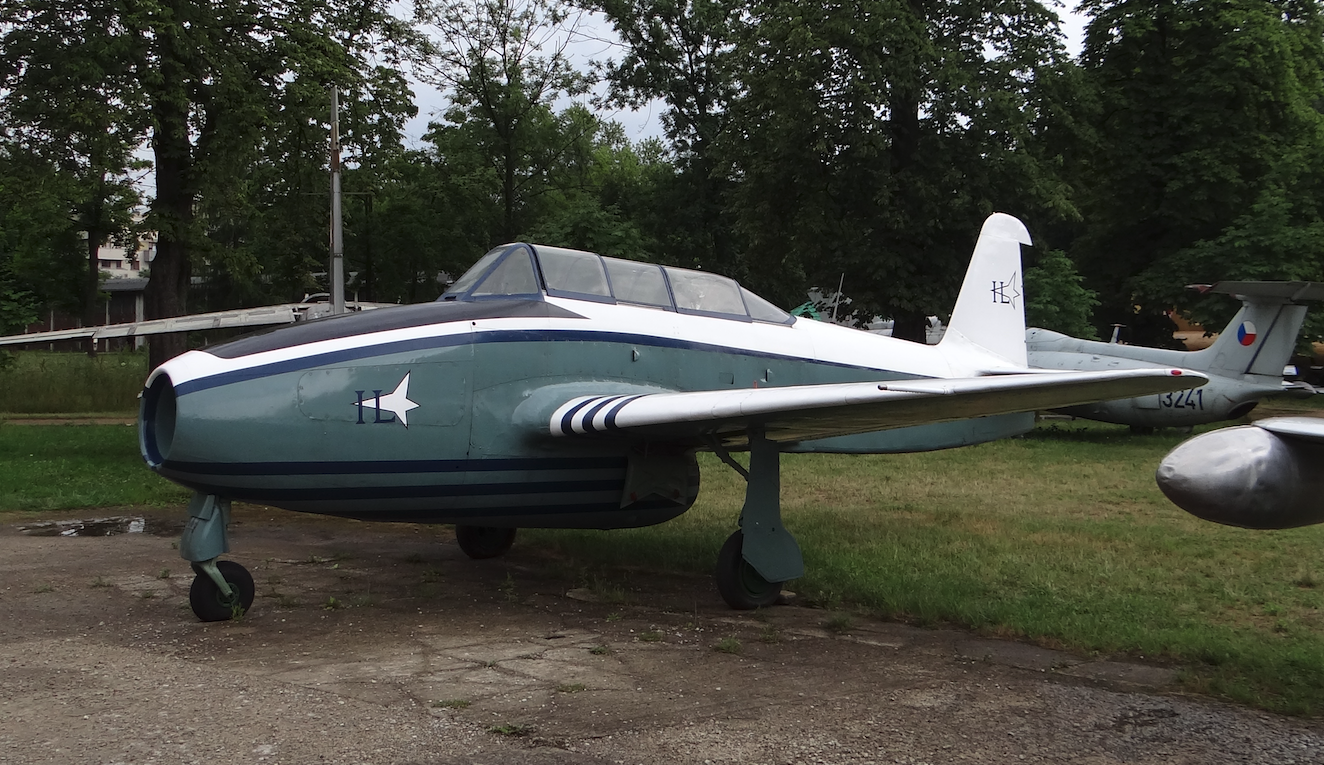
Construction Jak-17.
The aircraft is a single-seater, single-engine medium wing with almost all metal construction and straight wings. A truss structure covered with sheet metal. Often referred to in the publications as the transition type, which should be understood that the design at the time of introduction into the armament was already outdated. And there is no wonder, because it was based on the piston aircraft Jak-3. The Jak-17 itself was a somewhat improved first Soviet Jak-15 jet.
The wings are straight, double-girder with a slight rise, of duralumin construction. A typical outline of aircraft wings from World War II. Wings equipped with ailerons and crocodile flaps. At the end of the wings, locks were installed to hang additional fuel tanks.
The fuselage is of redane type, made as a truss made of steel pipes, covered with duralumin sheet. The hull was profiled from below and from above. The turbojet engine was located in the front of the fuselage, with the nozzle placed under the fuselage, at the height of the pilot's cabin. The tail part of the hull was covered with heat-resistant sheet underneath. Internal fuel tanks were placed only in the hull. The pilot's cabin is closed, glazed, not hermetic. The cover consisted of a three-part fixed windbreak and a convex guard sliding backwards.
Classic metal structure. The rudder, as the only element, was covered with canvas.
The landing gear is three-wheeled with a front wheel, retractable in flight; main shaver hidden in the wings. In the retracted position, none of the wheels is completely covered. The front undercarriage assembly is mounted almost outside the fuselage and partly covered with fairings.
Construction Jak-17 W. Two-seater version.
At the end of the wings there are no locks to suspend additional fuel tanks. However, there is a suspicion that aircraft operated in Poland have been equipped with them.
Two-seater cabin with tandem seats. Space for a second seat is obtained by extending the cabin slightly forward and backward. It was covered with a several-piece long joint cover, with parts for crew members moved back.
The aircraft has no weaponry, although it was possible to build it. This was not done, however, because the machine became too heavy and the weak drive could not cope with it.
Engine Jak-17.
One turbojet engine with axial compressor RD-10 A, with 1 x 9.80 kN (1 x 1000 kG) thrust. This engine is a development of the German Junkers Jumo 004 engine. In Poland, 30 additional engines of this type were built in Rzeszów.
The Jak-17 W aircraft operated in Poland were also powered by an earlier version of the RD-10 engine, with 1 x 8.83 kN (1 x 900 kG) thrust, at 8,700 rpm.
Starting the RD-10 engine is described in the history of the aircraft.
The fuel supply is 640 liters in the hull, plus 2 x 180 liters in suspended tanks. Fuel: kerosene T - 1, and pure gasoline B-72, B-90, + 5% MS.

Equipment
On-board FM transceiver RSI-6 type. Radiopółkompas.
Armament
2 cannons 23 mm NS-23 23 mm (60 cartridges each) at the bottom of the fuselage. Jak-17 W (UTI) was unarmed.
Date T-T aircraft Jak-17.
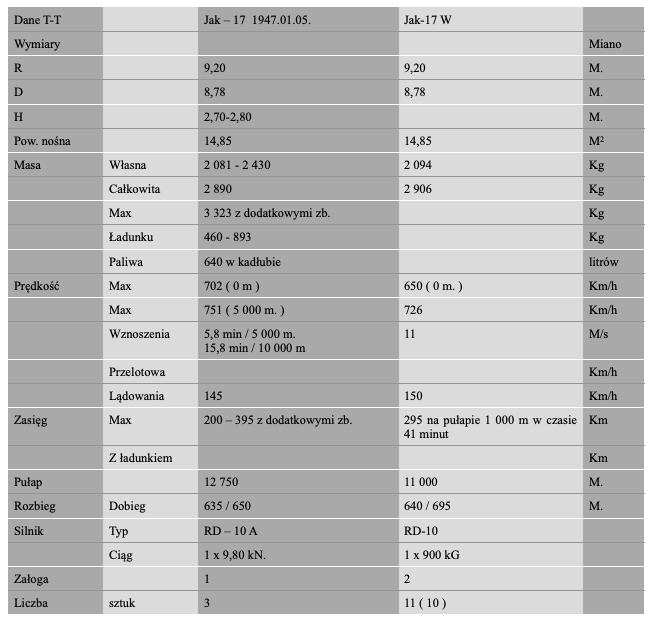
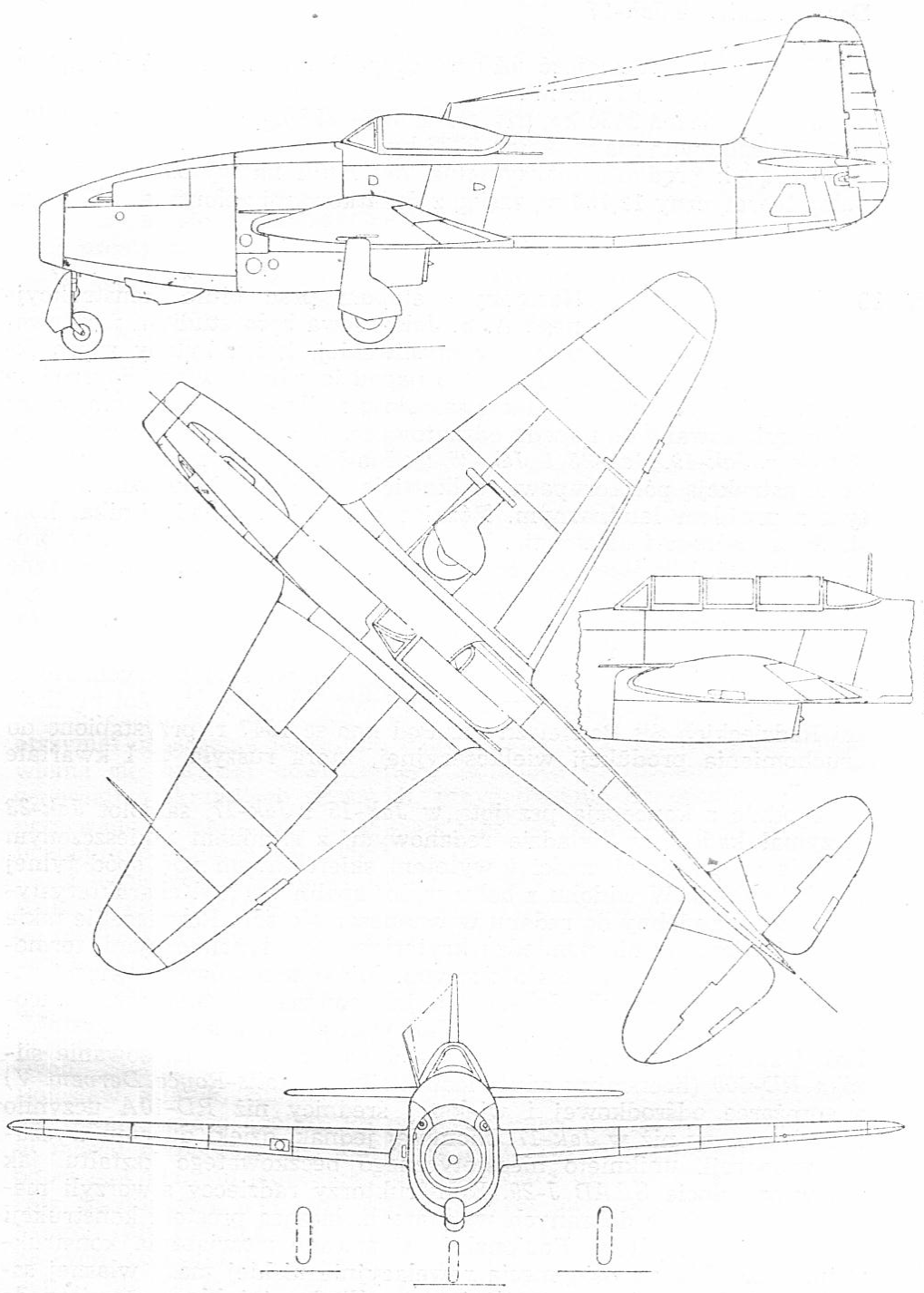
Written by Karol Placha Hetman
Kraków 2007-02-07
085b Section 1950-08-20
OKB Jakowlew Jak-17 / W „Agata”
Poland
The first Polish turbojet fighter aircraft.
Tally of aircraft Jak-17 / W Agata operated in Poland.
Jakovlev Jak-17 nb 29, 1950. Shown publicly on August 20, 1950, at Okęcie Airport.
Jakovlev Jak-17 nb unknown, 1950. Initially, it remained as a spare.
Jakovlev Jak-17 nb unknown, 1950. Passed to Mielec as a template for license production, as G-1. Serial production did not start.
Jakovlev Jak-17 W No. 3120008 nb 4 (04), SP-GLM. 1951. The aircraft served in 1 PLM in Bemowo. On August 18, 1951, he was transferred to 13 PLM in Łęczyca. At the beginning of 1952, he was in stock 39/40 PLM in Mierzęcice. In March 1, 1957, he was transferred to the Institute of Aviation. SP-GLM On February 3, 1960, he made his last flight. Handed over to the museum in Krakow and received the fictitious number 02. In 2017, the aircraft was renovated and received the colors in which it performed flights at the Institute of Aviation and registration SP-GLM.
Jakovlev Yak-17 W No. 3120127 nb 7 (1). 1951. The aircraft served in 1 PLM. In January 21, 1957, he was the first to go to the Institute of Aviation. It was probably a spare part warehouse.
Jakovlev Jak-17 W No. 3120145 nb unknown. 1951. The plane was used to train 2 MPL pilots from Krakow-Czyżyna.
Jakovlev Jak-17 W No. 3120124 nb unknown. 1951. The plane was used to train 2 MPL pilots from Krakow-Czyżyna.
Jakovlev Jak-17 W No. 3120037 nb unknown. 1951. December 1951, he served in 11 PLM Krzesiny.
Jakovlev Jak-17 W No. 3120038 nb unknown. 1951. December 1951, he served in 11 PLM Krzesiny.
Jakovlev Jak-17 W No. 3120141 nb unknown. 1951. December 1951, he served in 11 PLM Krzesiny.
In total, there were three Jak-17 (single-seater) and 10 (11) Jak-17 W (two-seater) aircraft in Poland. Currently, there is only one Jak-17 W SP-GLM aircraft in Poland at the Krakow museum.
Written by Karol Placha Hetman
